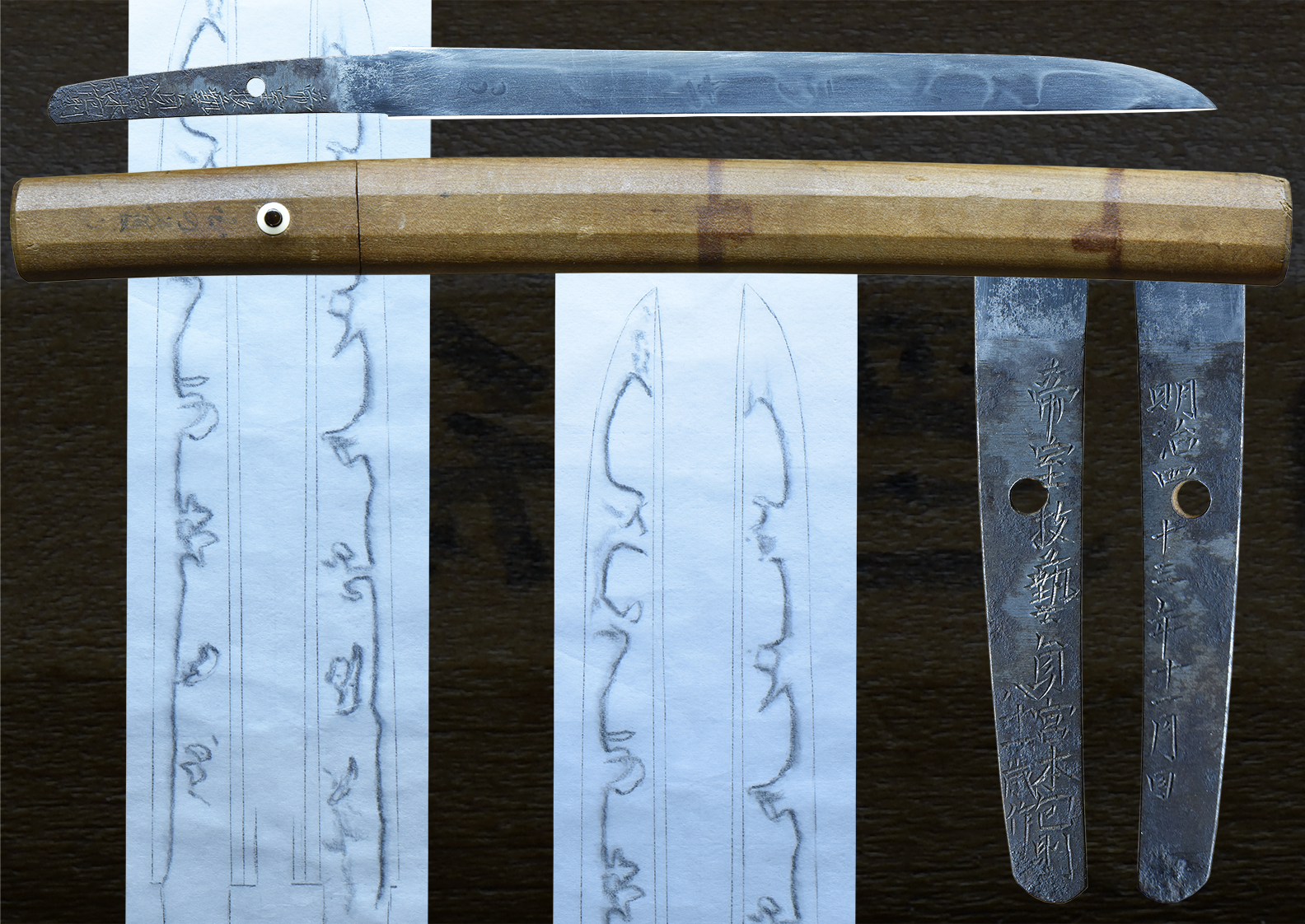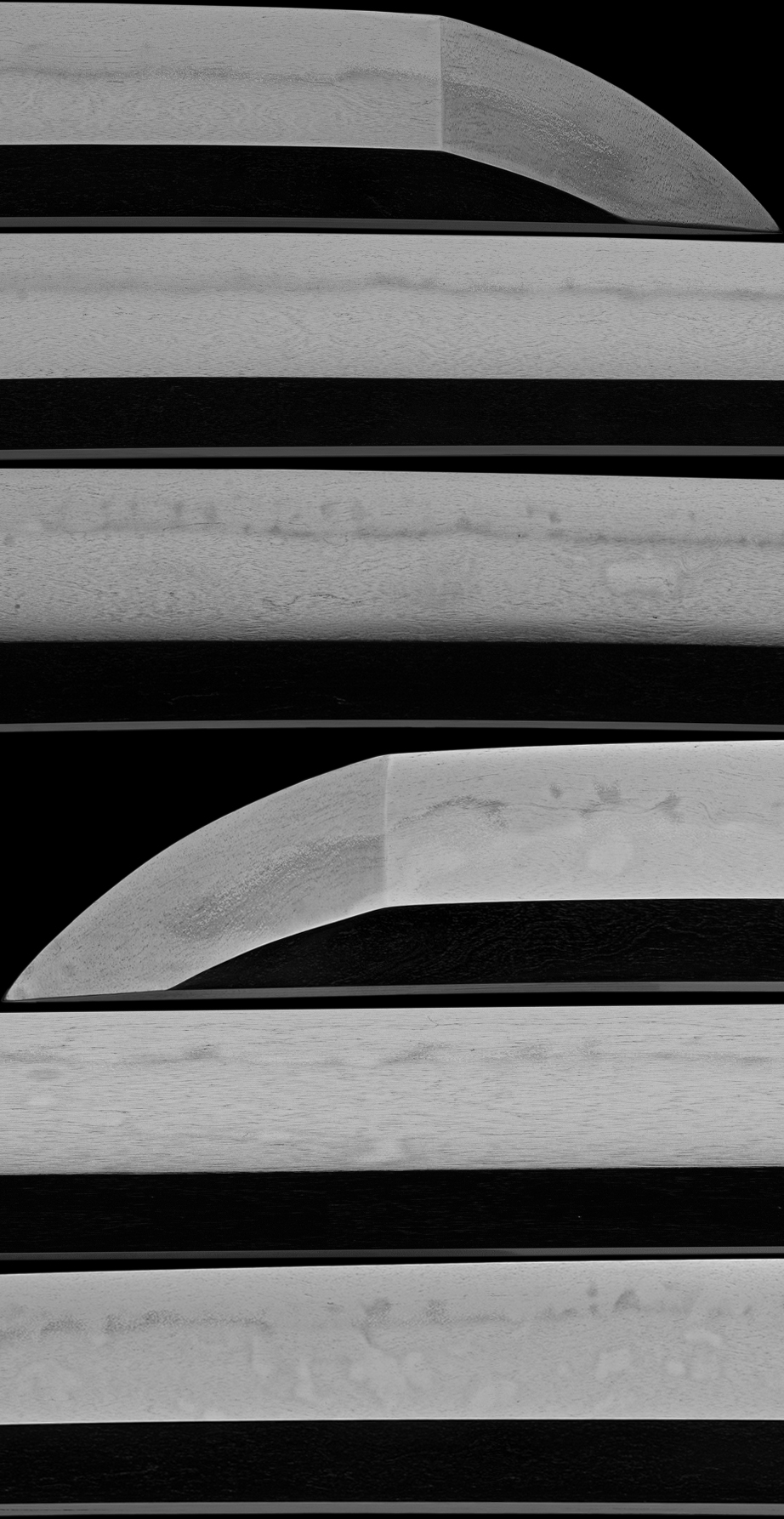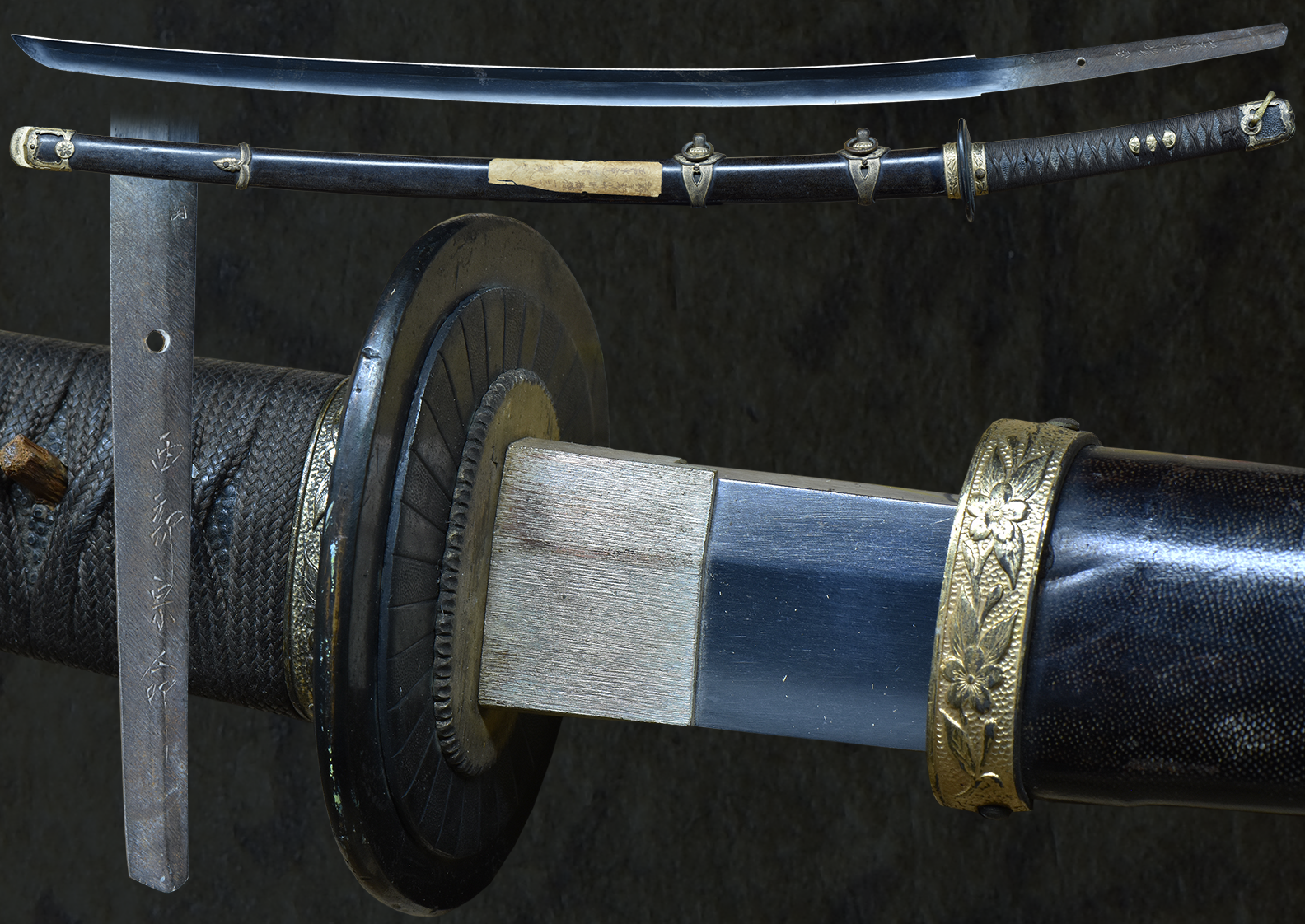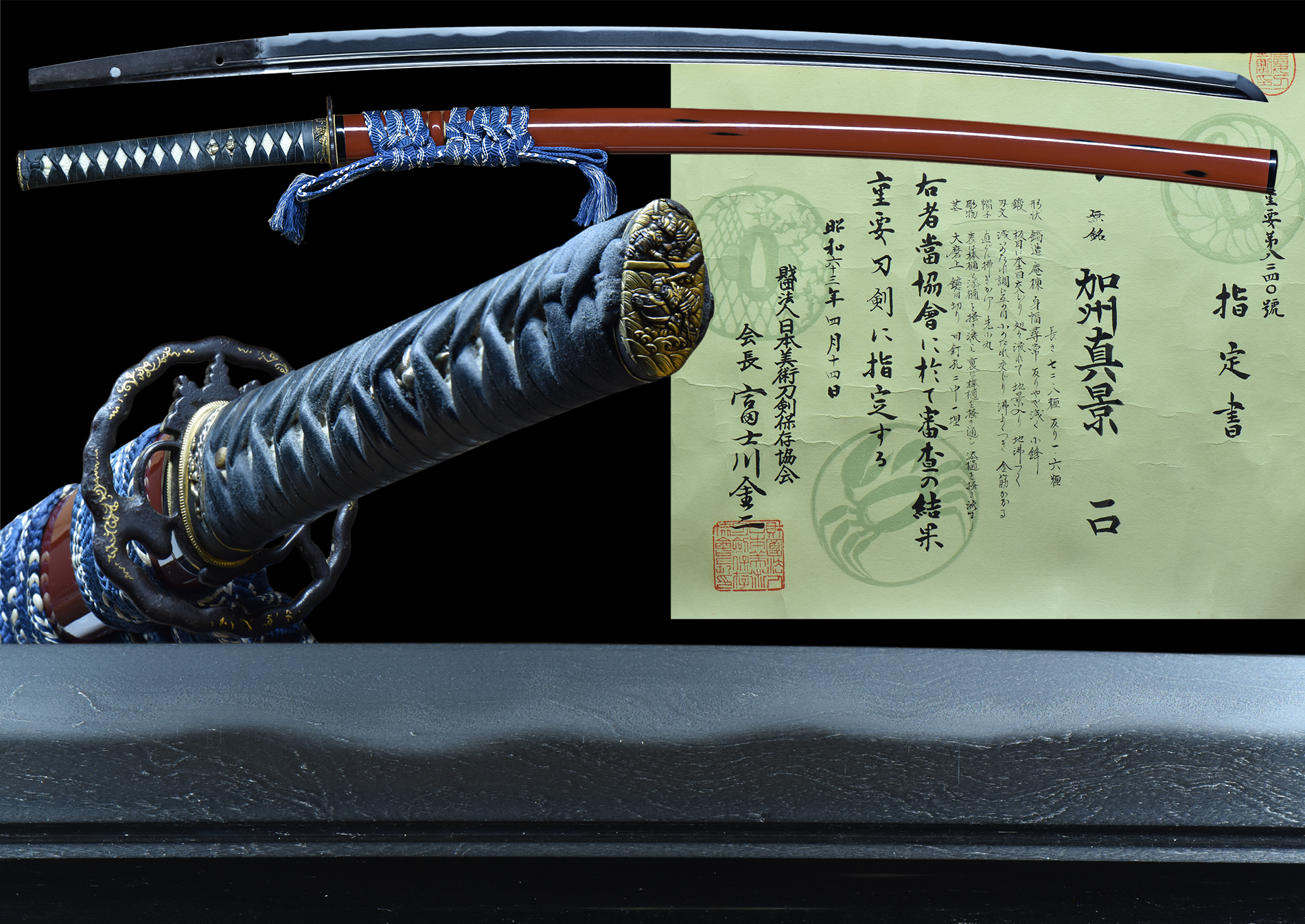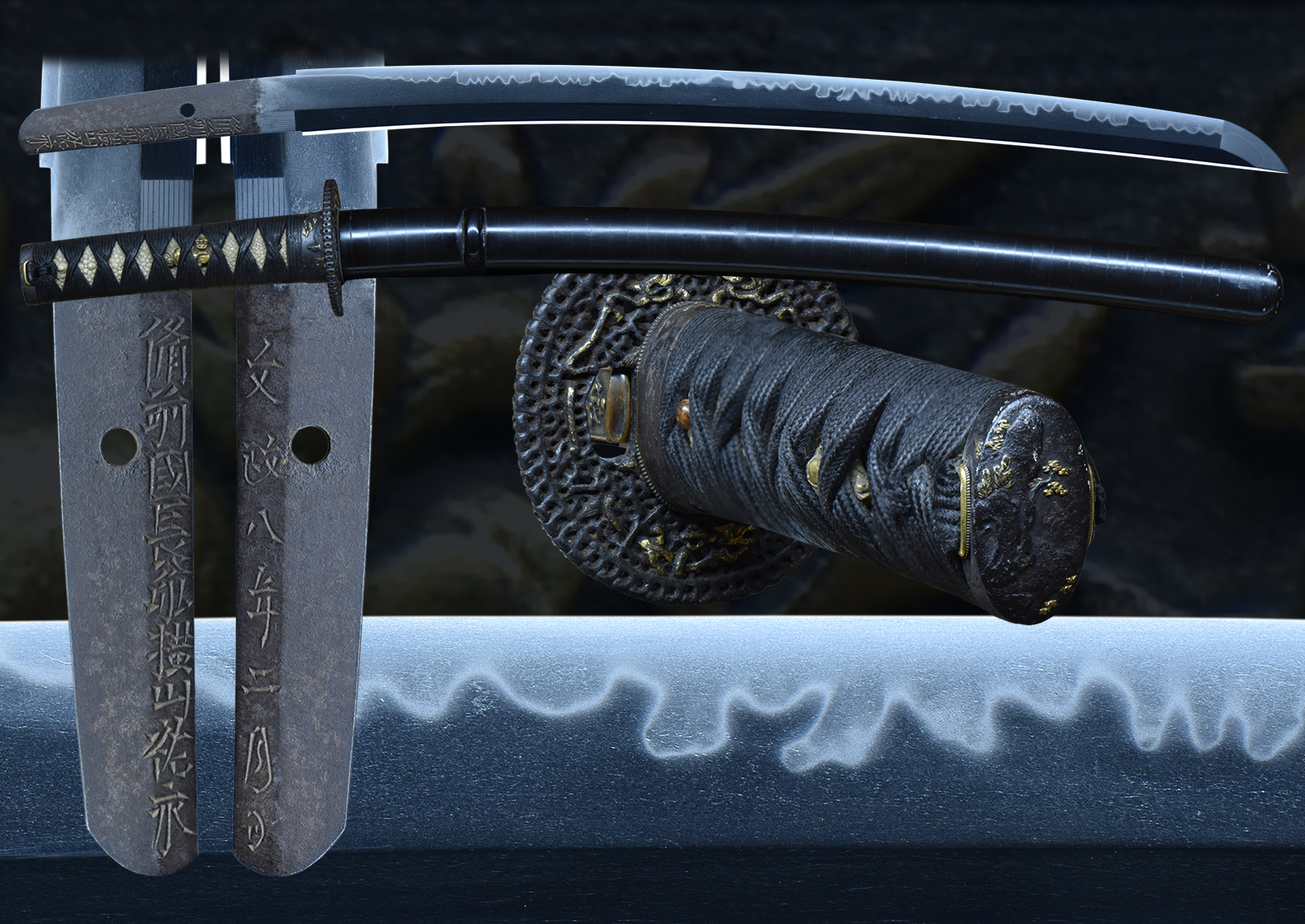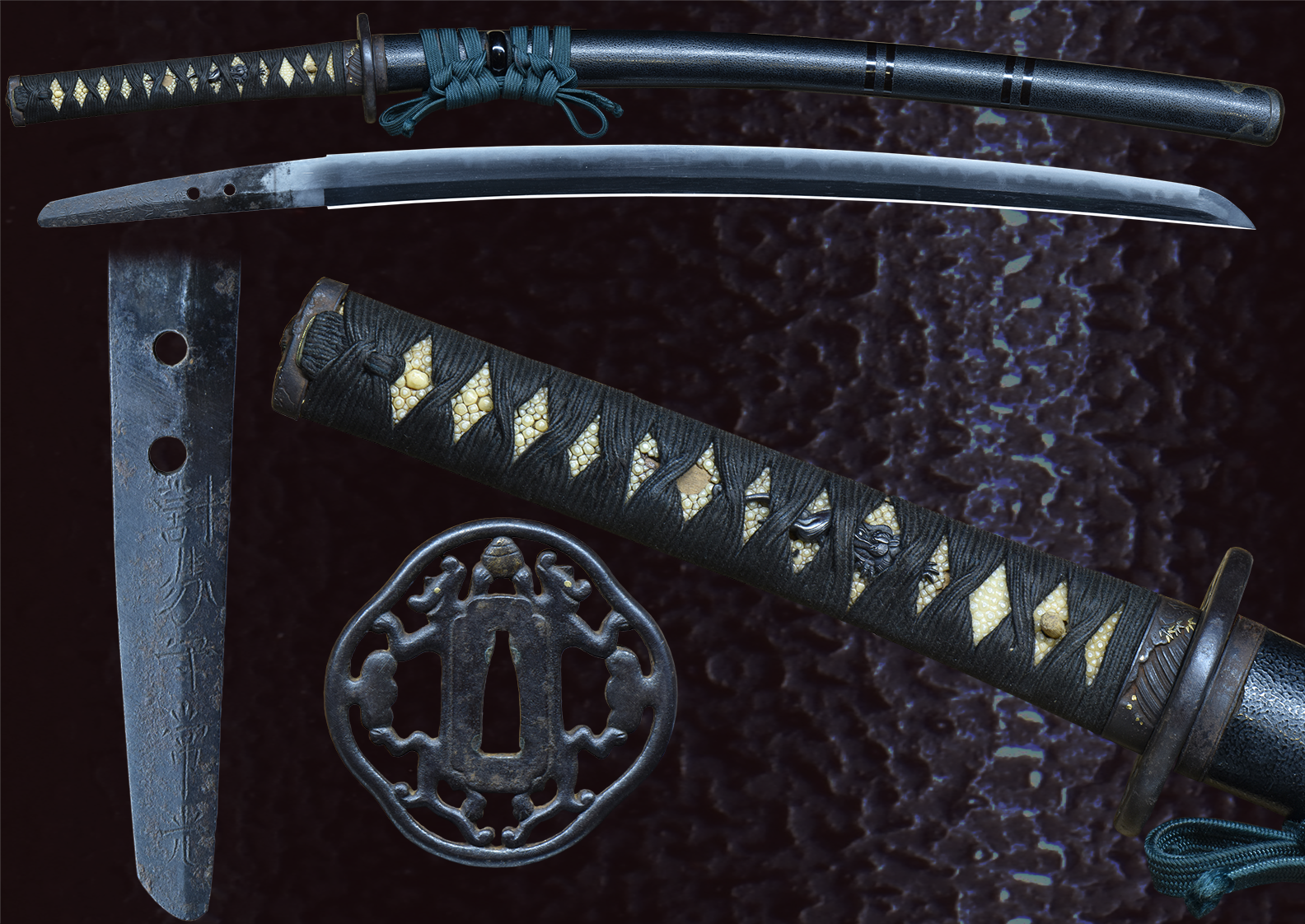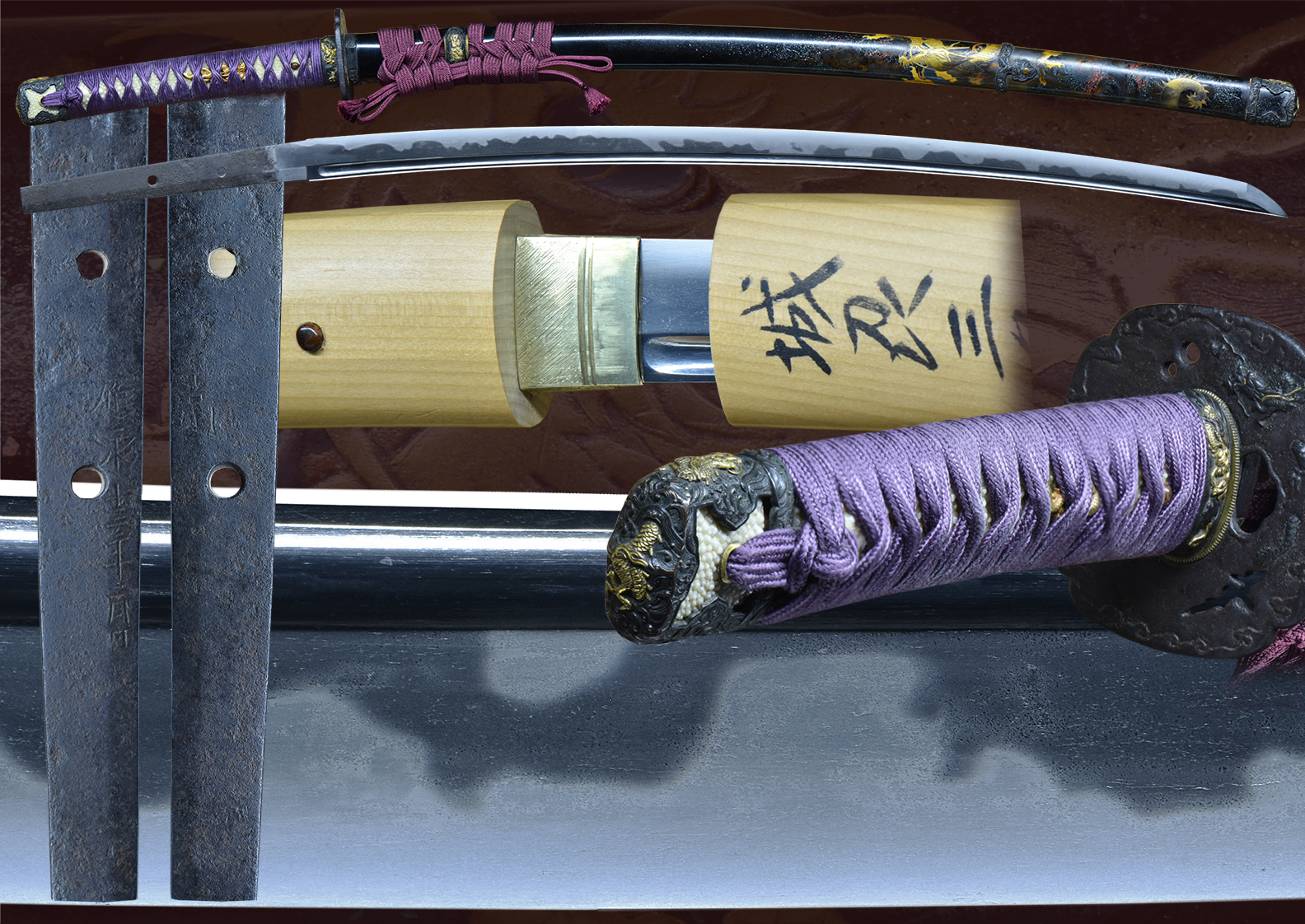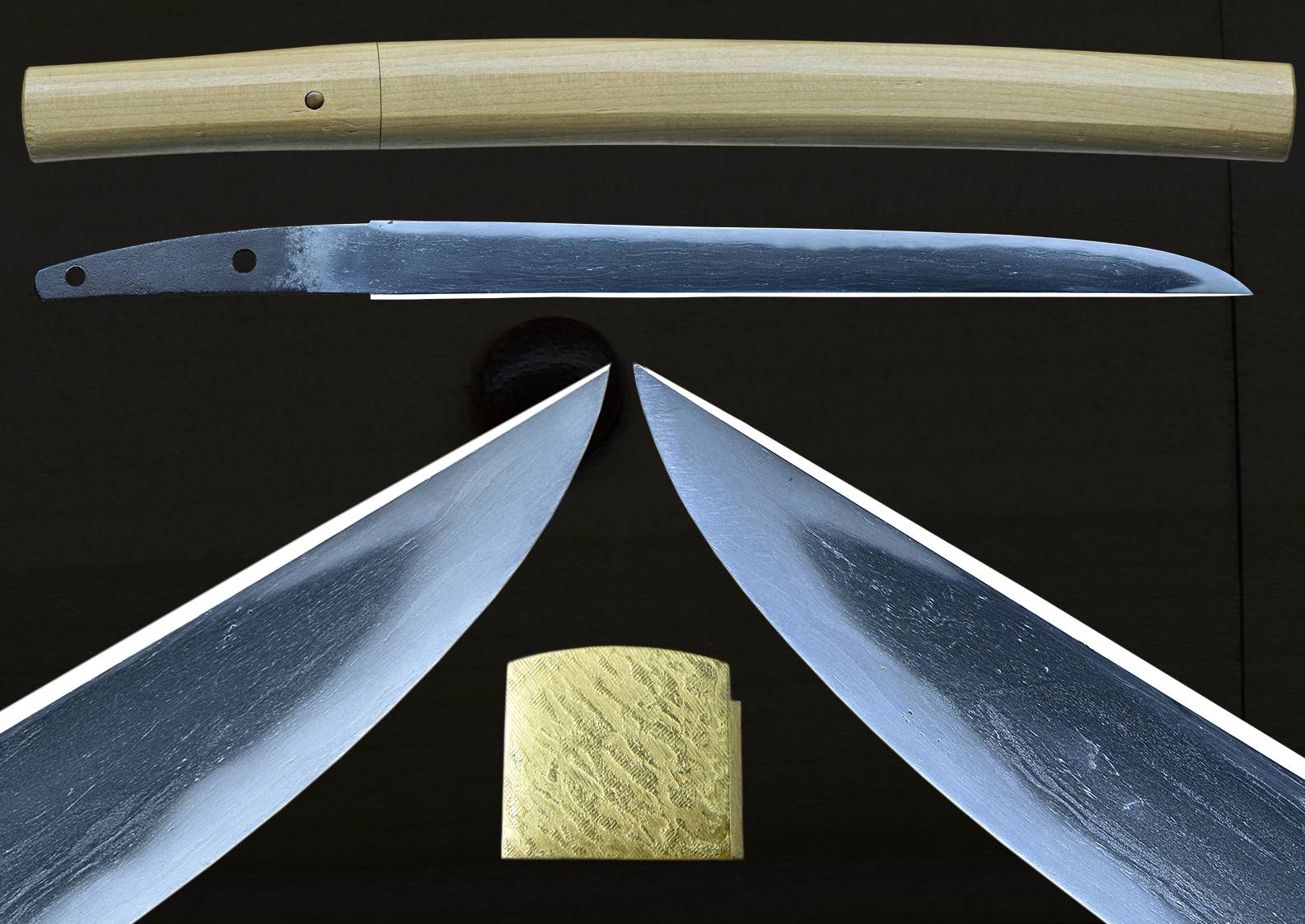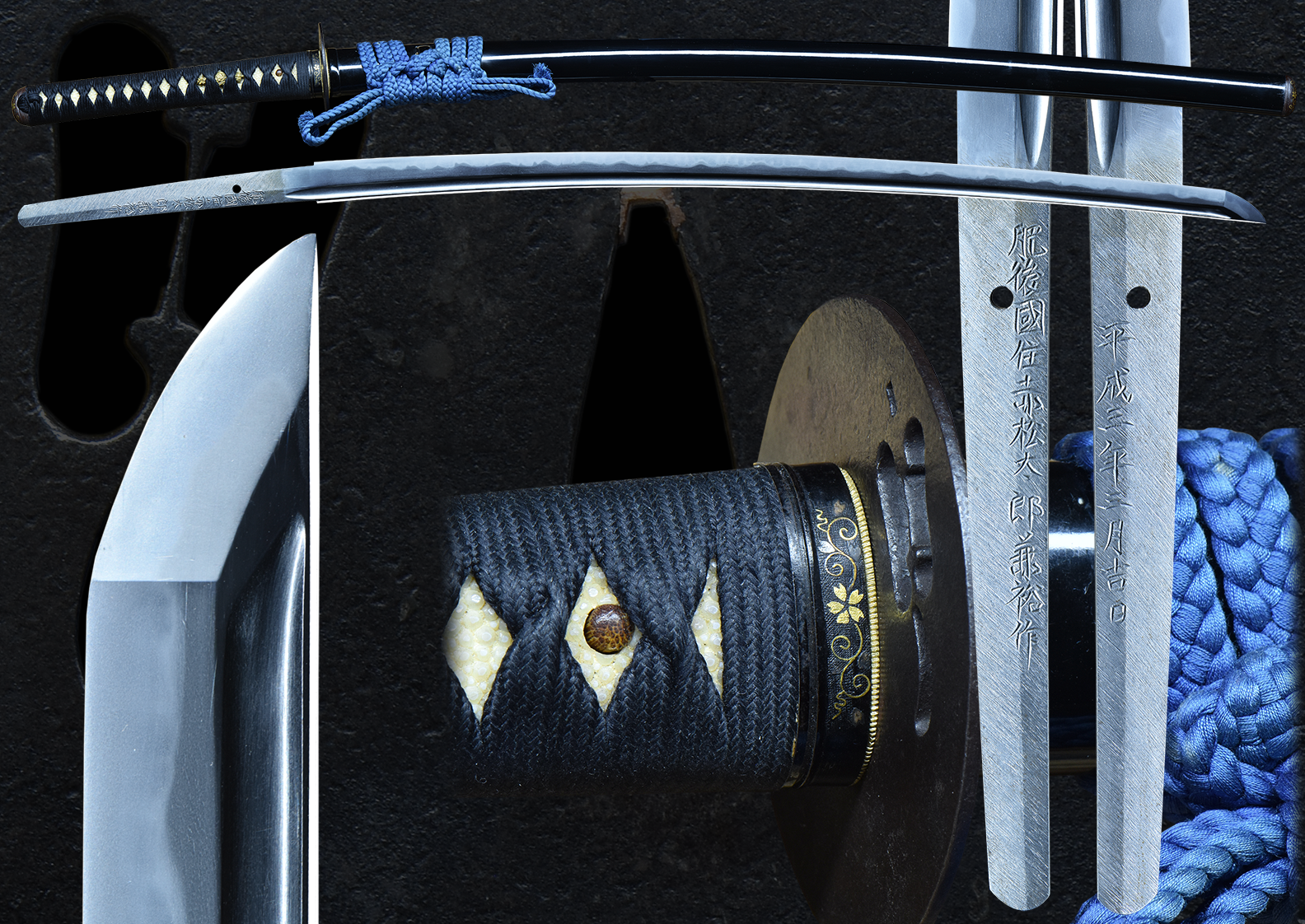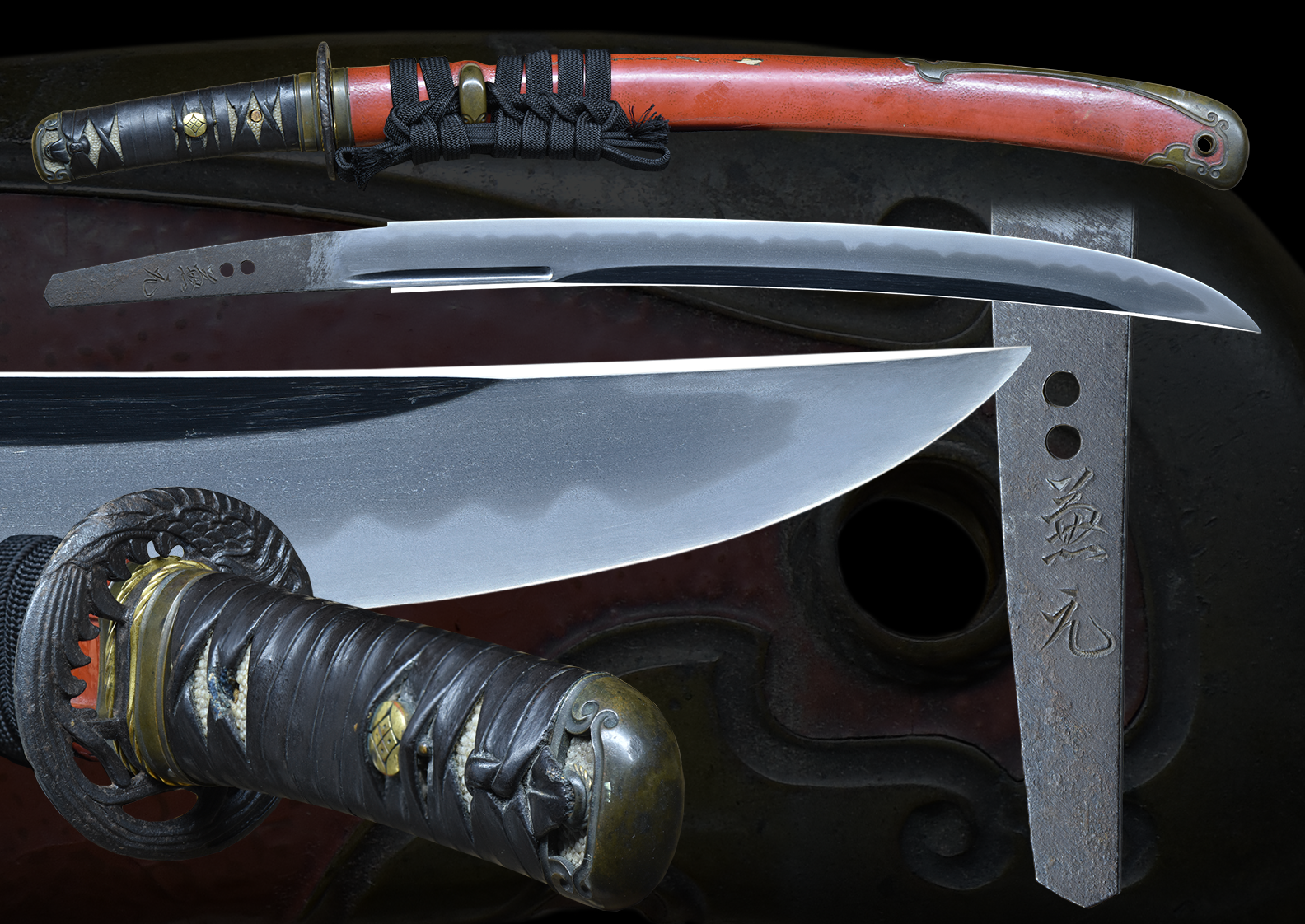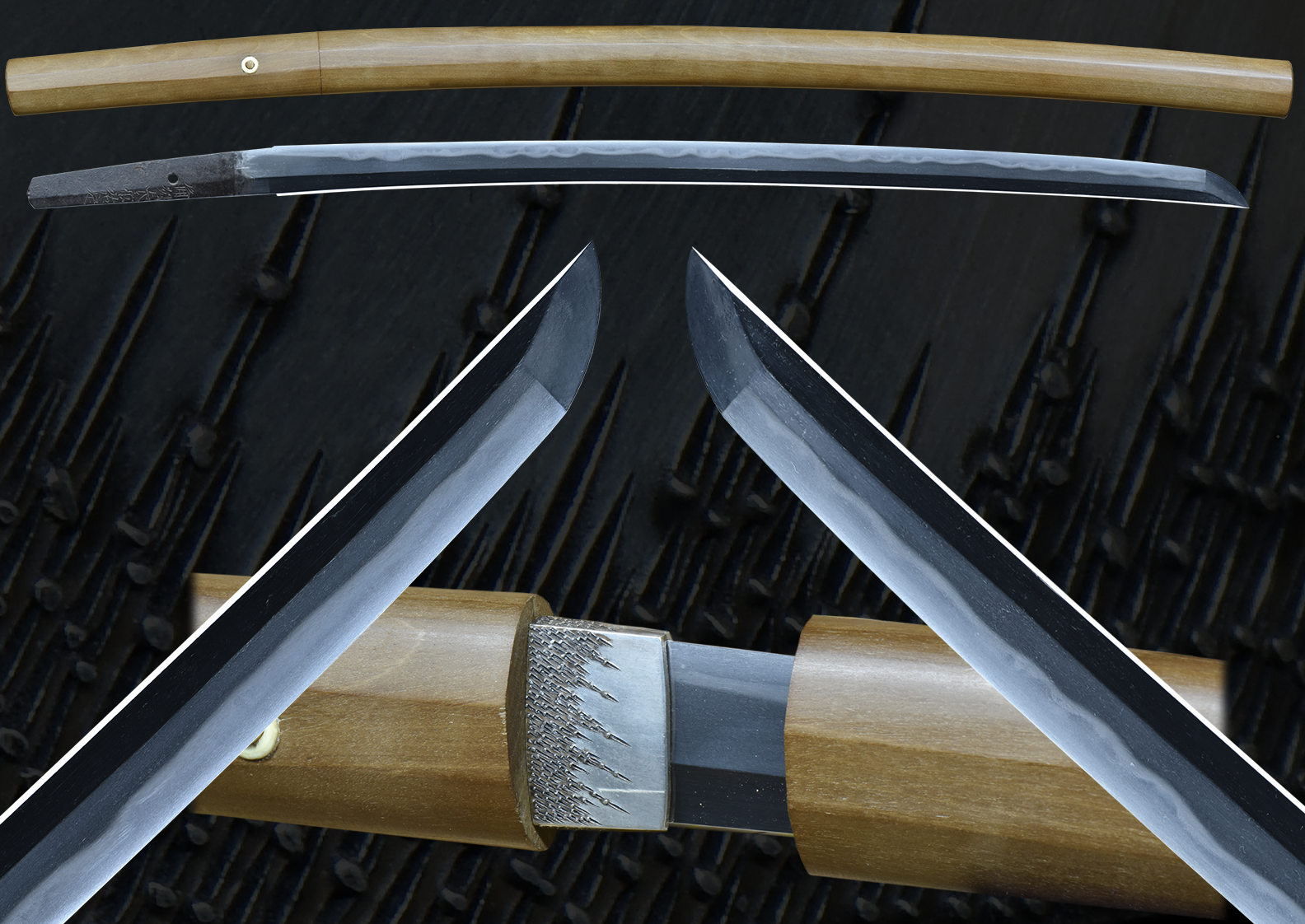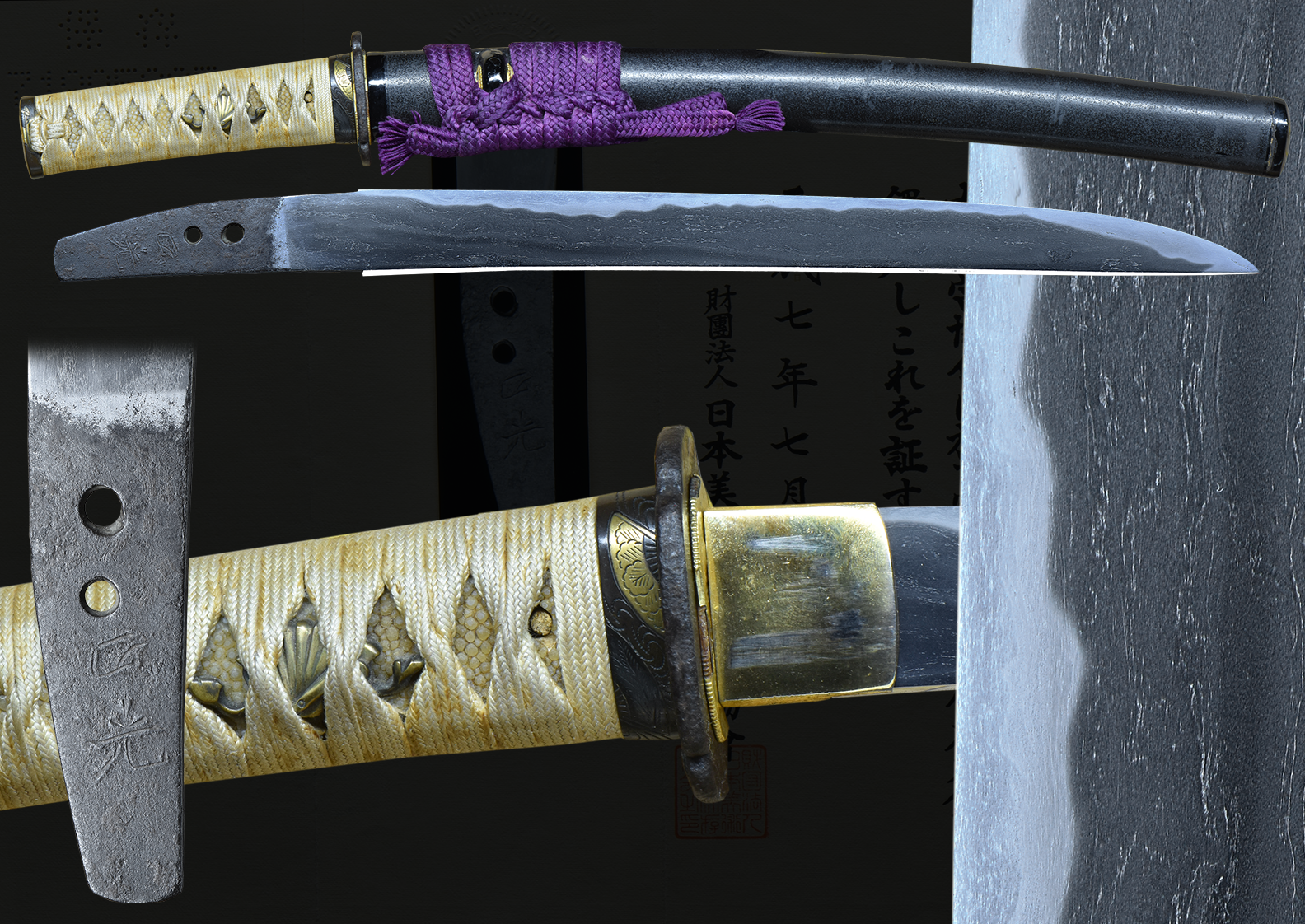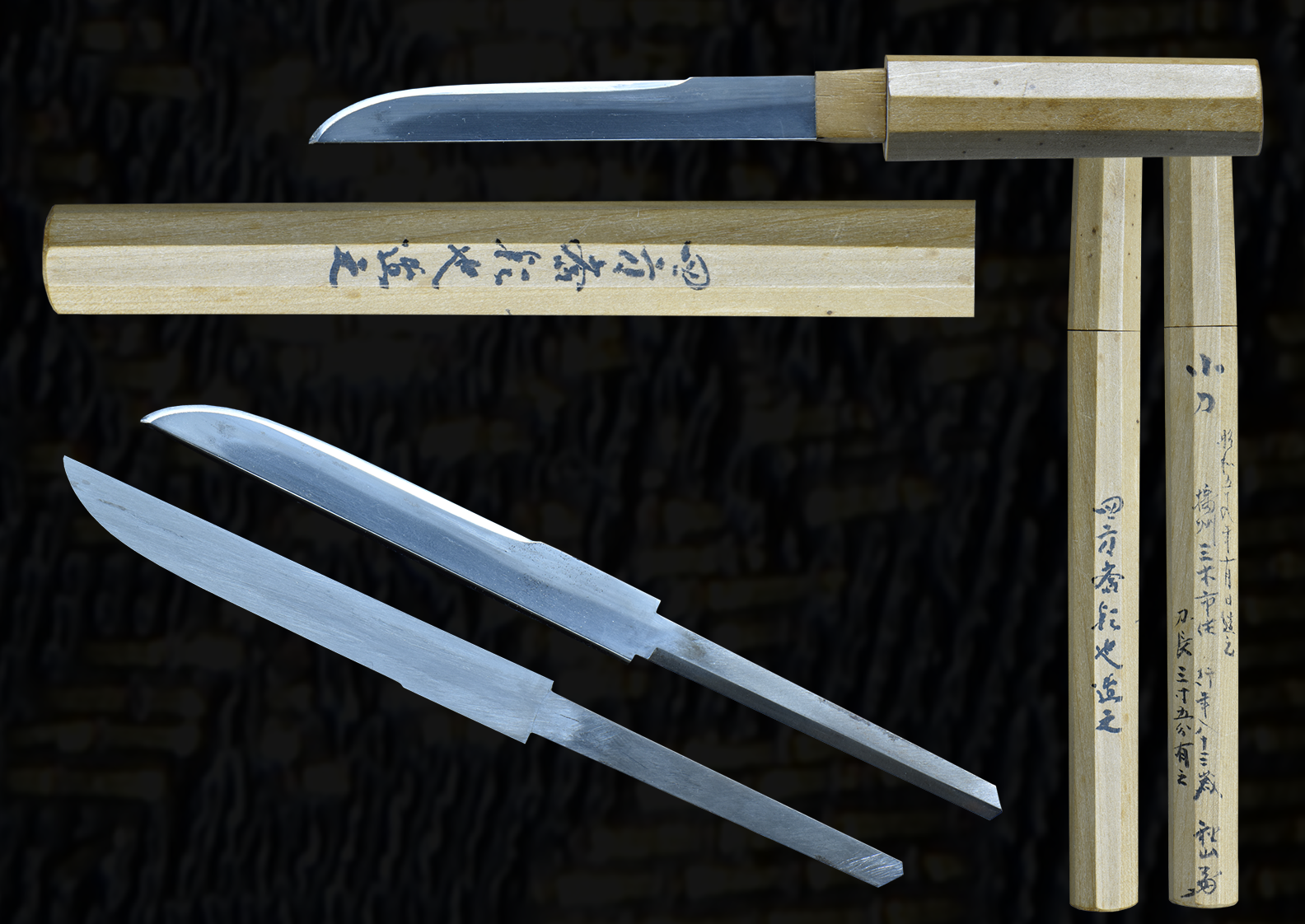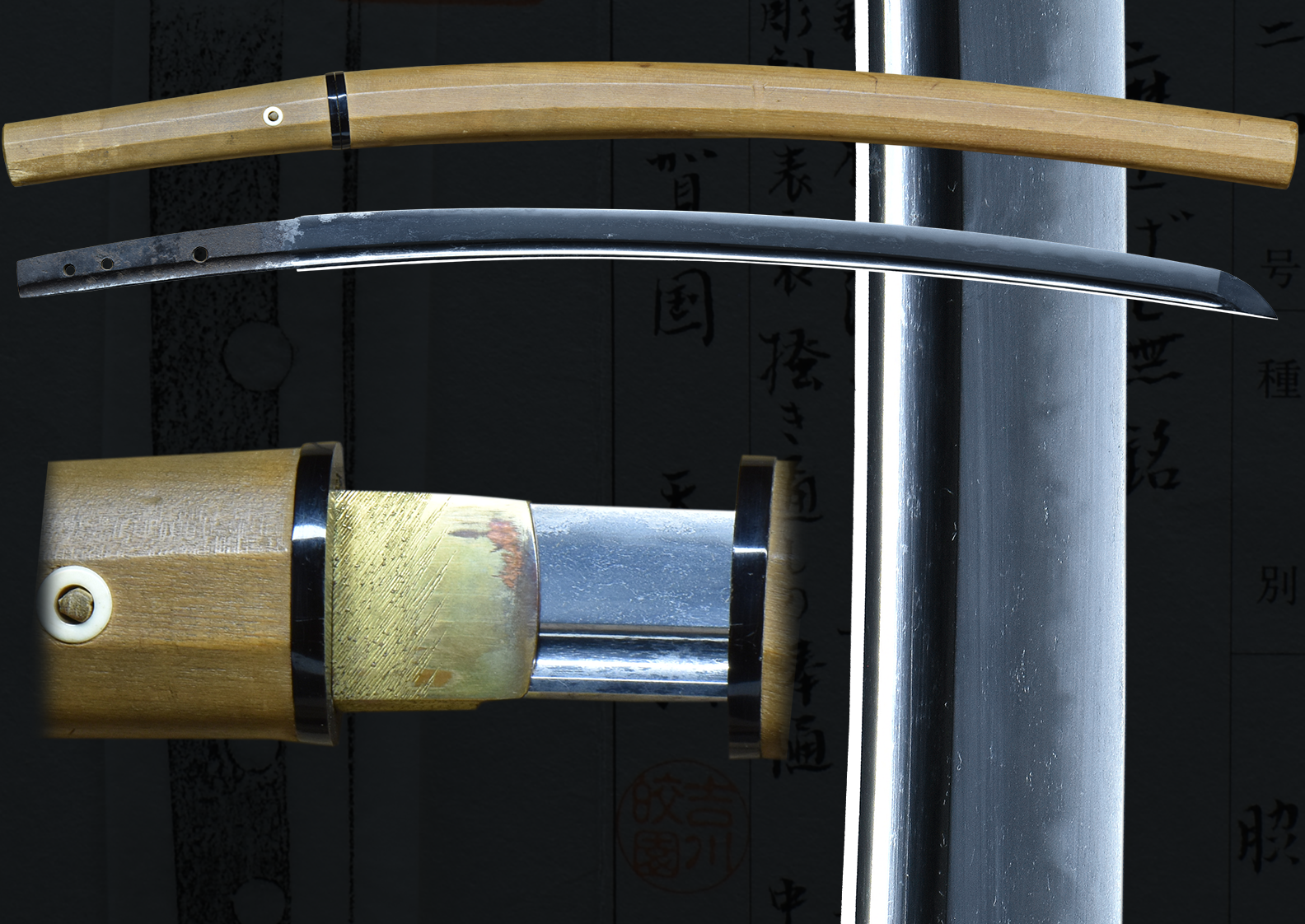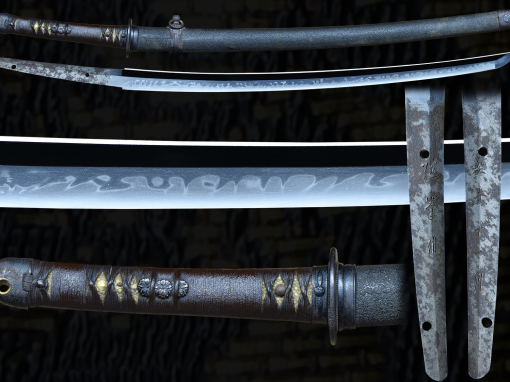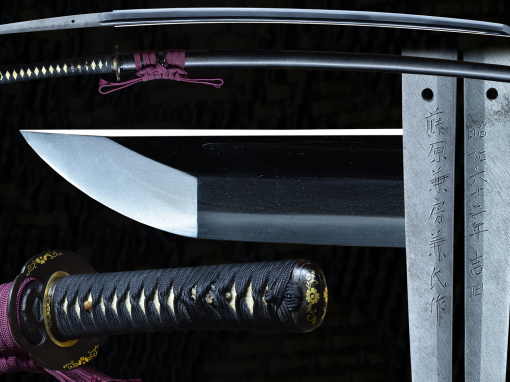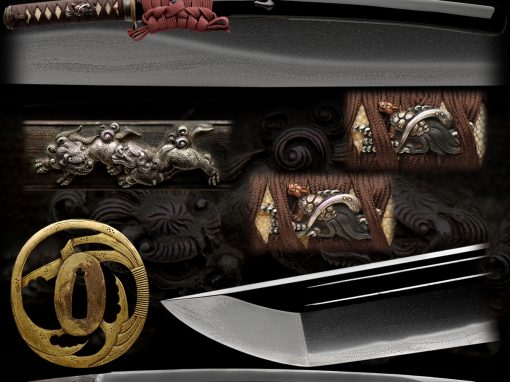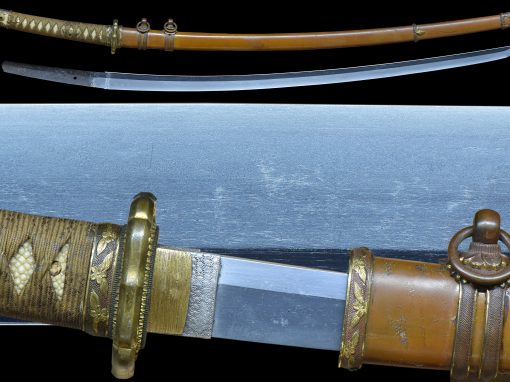This is a very interesting Katana in the Koto tradition that appears Soshu in character and attributed to Fuyuhiro and of the late muromachi era. It is in a nice polish and has a cutting edge of over 27″ and appears ubu and mumei. The overall shape of this Katana is impressive and the hamon is loaded with activity. The hamon contains plentiful nie with Suagashi and Kinsuji to be seen as well as some tobyaki. The hada has a milky slick looking finish and forged very well with some areas of O- hada mixed in. This blade comes in shirasaya with horn insert..
The Hamon is a brilliant Midare-ba based in sugu-ba with gunome present and loaded with activity. The hada is a swirling itame-nagare and some Masame with many hataraki as well. There is chikei and profuse ara-nie as well as ji-nie. Tobyaki, ashi and yo is quite prevalent. The boshi is a thick hakikake
The tang shape is unusual and is usually sometimes associated with other schools and smiths of Soshu origin. These swords are known to have FUYUHIRO HADA. It is flowing with MASAME that stands out. JI-NIE. MIDARE, NOTARE-MIDARE and GUNOME-MIDARE. 3rd generation banners greater exuberance with TOBI-YAKI, MUNE-YAKI and HITATSURA in KO-NIE.
The most prolific FUYUHIRO can be found with a standing HADA with JI-NIE. SUGUHA, GUNOME-MIDARE and
NOTARE BA. GUNOME-MIDARE with TOBI-YAKI and MUNE-YAKI.
HITATSURA. Occasionally there is wide MIDARE HA with
more NIE but often the YAKIBA is a defined NIOI that
is narrow.
As well as the contributing factors of the activities of this sword and the prevalence of his work and the most prolific of these smiths we believe this to be the 3rd generation Fuyuhiro. This is a beautiful and interesting sword for any collector.
This katana comes in a shirasaya and has a ebony wooden habaki.
- Mei: Mumei
- Date: koto (1500’s muromachi)
- Nagasa: 27.1/8 inches
- Sori: 24.0 mm
- Width at the ha-machi: 28.7 mm
- Width at the yokote: 19.7 mm
- Thickness at the mune-machi: 7.7 mm
- Construction: Shinogi zukuri
- Mune: Iori
- Nakago: Ubu
- Kitae: Itame masame
- Hamon: Midare Gunome
- Boshi: maru
- Condition: Good polish
Click to Enlarge Image
Please note that the color of these images are not what the sword looks like in hand.
High power lighting was used to bring out the details of this sword, making the hamon and hada more visible.
(shipping and insurance included)
Email us if your interested in this item and remember to include the order number for this item: fss-695.
Click to Enlarge Image
kantei-sho (鑑定書) No 381702 katana, mumei: Fuyuhiro (冬広)
nagasa 2 shaku 2 sun 8 bu han Migi wa tô-kyôkai ni oite shinsa no kekka, hozon-tôken to kantei-shi kore o shô-suru.
(右は當協會に於て審査の結果保存刀剣と鑑定しこれを証する)
Heisei nijûichinen ichigatsu nijûkunichi (平成二十一年一月二十久日)
zaidan-hôjin (財團法人): Nihon Bijutsu Tôken Hozon Kyôkai (日本美術刀劍保存協會)
Appraisal
katana, unsigned: Fuyuhiro
nagasa ~ 69.3 cm According to the result of the shinsa committee of our society we judged this work as authentic and designate
it as hozon-tôken. January 29th 2009 [Foundation] NBTHK
FUYUHIRO school information:
FUYU (冬)
FUYUHIRO (冬広), 1st gen., Kōshō (康正, 1455-1457), Wakasa – “Jakushū-jū Fuyuhiro” (若州住冬広), “Fuyuhiro” (冬広), according to tradition the son of the 2nd gen. Sōshū Hirotsugu (広次) who had moved later in his career from Sagami to Obama (小浜) in Wakasa province, there he founded the quite successful Fuyuhiro school which gave rise to many smiths, he worked in an itame-nagare mixed with masame and ji-nie and the hada can either stand out or is finely forged, the hamon is a suguha or a notare mixed with gunome, tantō show mostly a hoso-suguha and a jihada that tends somewhat to ayasugi, chūjō-saku
FUYUHIRO (冬広), 2nd gen., Chōkyō (長享, 1487-1489), Wakasa – “Jakushū-jū Fuyuhiro saku” (若州住冬広作), “Fuyuhiro saku” (冬広作), “Hakushū-jū Fuyuhiro saku” (伯州住冬広作), he lived in Obama (小浜) in Wakasa province but worked also in Bizen and Hōki, there exists a date signature of the 13th year of Eishō (永正, 1516) in combination with the information made at the age of 53, this calculates his year of birth as Kyōtoku two (享徳, 1453), suguha, notare, gunome-midare, chū-saku
FUYUHIRO (冬広), 3rd gen., Daiei (大永, 1521-1528), Wakasa – “Fuyuhiro saku” (冬広作), “Jakushū-jū Fuyuhiro” (若州住冬広), “Kyū ́emon no Jō Fuyuhiro” (久右衛門尉冬広), first name Kyū ́emon (久右衛門), most of the today known Fuyuhiro works of this lineage go back to the hand of this generation, mostly a standing-out itame-nagare with masame and ji-nie, the hamon is a suguha, notare or gunome-midare in ko-nie-deki, whereas also works with tobiyaki and muneyaki can be found that tend to hitatsura, interpretations in midareba have a wide mihaba and plenty of nie, sometimes the yakiba is narrow and has a tight nioiguchi, his tang has a Sōshū-typical funagata-like shape, the tip of the tang is a pronounced ha- agari kurijiri
FUYUHIRO (冬広), 4th gen., Eiroku (永禄, 1558-1570), Wakasa – “Jakushū-jū Fuyuhiro” (若州住冬広), “Wakasa no Kami Fuyuhiro” (若狭守冬広), “Bizen no Kuni-jū Fuyuhiro” (備前国住冬広), “Fuyuhiro Tōzaemon no Jō” (冬広藤左衛門尉), “Bitchū no Kuni Matsuyama ni oite Jakushū-jūnin Fuyuhiro saku” (備中国於松山若州住人 冬広作), he bore the first names Matajirō (又次郎) and Tōzaemon (藤左衛門), the honorary title Wakasa no Kami was granted to him on the eleventh day of the eighth month Eiroku seven (1564), he moved later to Matsuyama (松山) in Bitchū province to work there on the invitation of Mimura Motochika (三村元親, ?-1575), the castellan of Matsuyama Castle, it is said that he also worked during the Tenshō era (天正, 1573-1592) in Bingo province, quasi on the way to Bitchū he also worked during the early years of the Daiei era (大永, 1521-1528) in Bizen province, the above mentioned signature with the prefix “Bizen no Kuni” is found on a blade with the date signature of Daiei two (1522)
FUYUHIRO (冬広), 5th gen., Keichō (慶長, 1596-1615), Wakasa – “Jakushū Obama-jū Fuyuhiro” (若州小浜住 冬広), “Jakushū-jū Fuyuhiro” (若州住冬広), “Wakasa no Daijō Fujiwara Fuyuhiro” (若狭大掾藤原冬広), “Wakasa no Kami Fuyuhiro” (若狭守冬広), real name Takahashi Gorōzaemon (高橋五郎左衛門), according to tradition the son of Sōshū Hirotsugu (広次) who later took over the Fuyihiro school when their 4th generation moved to Bitchū, the honorary title Wakasa no Kami was granted to him on the tenth day of the twelfth month Keichō three (1598), because
– 77 –
Kyōgoku Takatsugu (京極高次, 1563-1609) – the lord of the Obama fief (小浜藩) – bore the honorary title Wakasa no Kami too, Fuyuhiro later refrained out of respect from using this title and switched to the lower Wakasa no Daijō, chū-
saku, chūjō-saku
FUYUHIRO (冬広), 6th gen., Kan ́ei (寛永, 1624-1644), Wakasa – “Jakushū-jū Fuyuhiro” (若州住冬広), “Wakasa no Daijō Fujiwara Fuyuhiro” (若狭大掾藤原冬広), real name Takahashi Gorō ́emon (高橋五郎右衛門), from this period onwards the Fuyuhiro mainline did not bear the honorary title of Wakasa no Daijō in the strict sense, i.e. being granted with that title, but used it as a kind of “trademark”
FUYUHIRO (冬広), 7th gen., Kanbun (寛文, 1661-1673), Wakasa – “Jakushū-jū Fuyuhiro” (若州住冬広), first name Magosaburō (孫三郎)
FUYUHIRO (冬広), 8th gen., Genroku (元禄, 1688-1704), Wakasa – “Wakasa no Daijō Fujiwara Fuyuhiro” (若狭大掾藤原冬広), “Wakasa no Daijō Fujiwara Fuyuhiro nanban-tetsu o motte kore o saku” (若狭大掾藤原冬広以南蛮鉄作, “made by Wakasa no Daijō Fujiwara Fuyuhiro by using nanban-tetsu”), first name Jinbei (甚兵衛)
FUYUHIRO (冬広), 9th gen., Kyōhō (享保, 1716-1736), Wakasa- “Jakushū Obama-jū Fuyuhiro” (若州小浜住冬広), “Jakushū Unpinjō Fuyuhiro tsukuru” (若州雲浜城冬広造), “Wakasa Obama-jōhen Fuyuhiro tsukuru” (若狭小浜城辺冬広造), first name Jinbei (甚兵衛), Unpin (雲浜) is another name for Obama Castle
FUYUHIRO (冬広), 10th gen., Kanpō (寛保, 1741-1744), Wakasa – “Fuyuhiro” (冬広), first name Jinbei (甚兵衛) FUYUHIRO (冬広), 11th gen., Meiwa (明和, 1764-1772), Wakasa – “Fuyuhiro” (冬広), “Wakasa no Daijō Fujiwara Fuyuhiro Chōzaemon no Jō Masateru” (若狭大掾藤原冬広長左衛門尉正照), first name Jinbei (甚兵衛), it is unclear if this Fuyuhiro changed his name to Masateru (正照) or if the above mentioned signature goes back to a joint work of him and a Masateru
FUYUHIRO (冬広), 12th gen., Kansei (寛政, 1789-1801), Wakasa – “Fuyuhiro Saburōbei” (冬広三郎兵衛), “Fuyu- hiro” (冬広), first name Saburōbei (三郎兵衛)
FUYUHIRO (冬広), 13th gen., Bunsei (文政, 1818-1830), Wakasa – “Fuyuhiro” (冬広)
FUYUHIRO (冬広), 14th gen., Ansei (安政, 1854-1860), Wakasa – “Fuyuhiro” (冬広), first name Saburōbei (三郎兵衛) FUYUHIRO (冬広), 15th gen., Genji (元治, 1864-1865), Wakasa – “Fuyuhiro” (冬広), first name Chōsei ́emon (長正衛門)
FUYUHIRO (冬広), Genroku (元禄, 1688-1704), Wakasa – “Jakushū-jū Fuyuhiro” (若州住冬広), first name Saburōbei (三郎兵衛), he was the younger brother of the 8th gen. Fuyuhiro
FUYUHIRO (冬広), Kyōhō (享保, 1716-1736), Wakasa – “Jakushū Obama-jū Fuyuhiro” (若州小浜住冬広), “Fuyuhiro” (冬広), first name Chōzaemon (長左衛門), student of Saburōbei Fuyuhiro who was active around Genroku (元禄, 1688-1704)
Subscribe for the Latest Updates!
Join our mailing list to receive the latest News & Updates from Nihonto Antiques.
You have Successfully Subscribed!
For Sale
